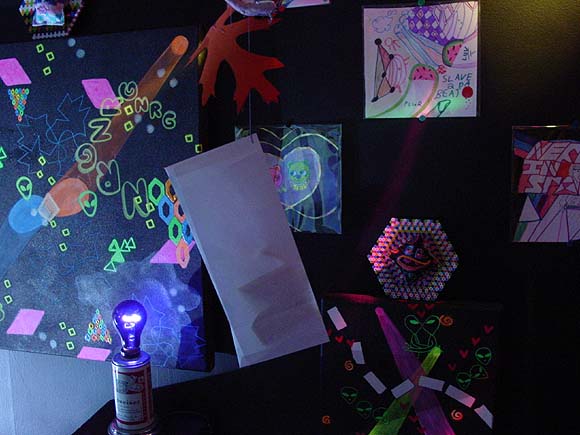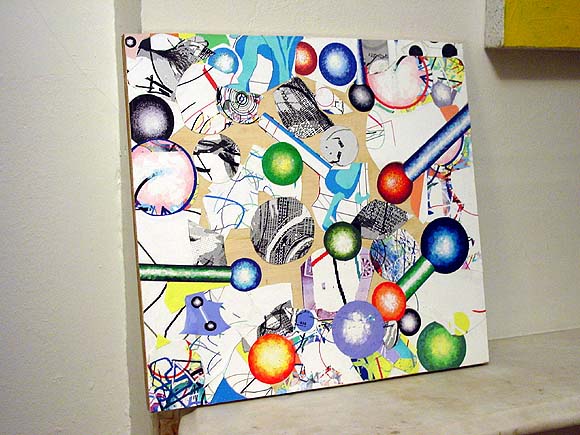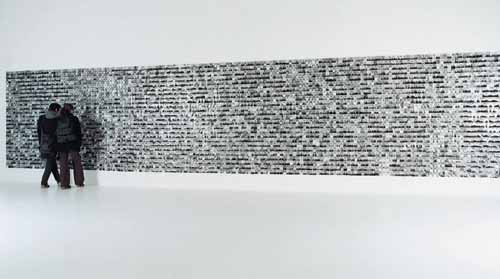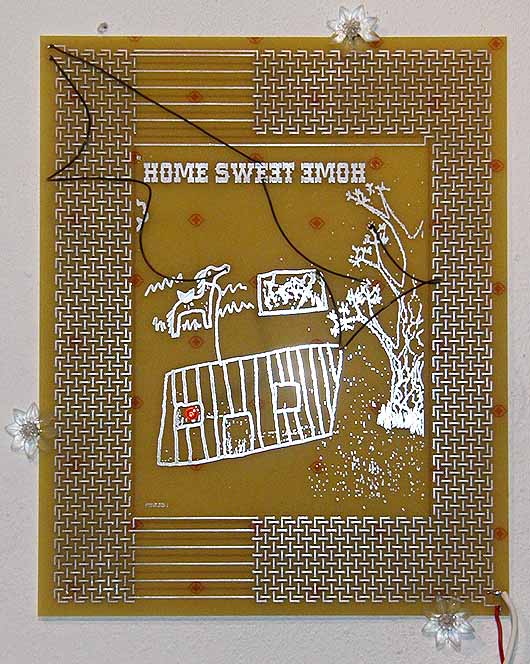View current page
...more recent posts


Images from Frankie Martin's installation "One Minute Rave," at Canada. Press a button outside a cloth-draped doorway, enter the room with the black light, strobe, and cardboard cutout DJ, and you have exactly one minute to freak out. Actually you can do it multiple times, but you have to keep sticking your hand outside the doorjamb to hit the switch that activates the music and lights. Some very nice handcrafted work, geometric patterns, psychedelic drawing, and pure kitsch from the era of smart drinks, glow in the dark whistles, and floor shattering bass lines. Which is still going on in many parts of the country, and/or in a state of being perpetually revived, as the '60s psychedelic thing continues to morph with new technology and new crops of initiates. The vibe might also be "the early years of rave" before the DIY spirit gave over to corporate interests, if that era ever in fact existed. Maybe it's just an ideal rave of the mind. To put it in some historical context, this was to the early '90s what Kenny Scharf's black light rooms were to the late '60s, but less sardonic and more girly--and I mean the latter in a good way. It's truer to the spirit of the show than saying "post-feminist" and it's certainly not grrr-ly.

Momenta Art in Williamsburg has its annual benefit coming up and I'm donating a piece. Jeez, the last time I did this was four years ago, shortly after I started this blog. Here's to both of us still being around in the world o'ephemera that is the art scene. I tried something new with the piece above, which is gluing the paper--many little cut out pieces printed with "drawn elements" from my home computer--directly onto a piece of plywood. I was expecting to struggle more but this came together fairly quickly--I'm happy not to drag out the process. Now, if I was Fred Tomaselli I'd collector-ify the piece by pouring polyurethane goo all over it, but I kind of hate that restaurant table decoupage look so I think I'll just give it a light coat of matte fixative and call it done. I like seeing the texture of the paper clinging to the wood--I also left some wood showing on the front, which I didn't expect to do. All this could change tomorrow but I only have a few more days to screw with it.
Tom DeLay Is Declasse
The New York Times tastefully summarized a recent paranoid speech by Tom DeLay, the former bug exterminator who was "mad about gummint regulation" and pretty much took over the US House of Representatives. Investigations are finally closing in on him so he's been desperately demagoguing on the "right not to die" issue. Here's more of his speech to the Family Research Council:
And so itís bigger than any one of us, and we have to do everything that is in our power to save Terri Schiavo and anybody else that may be in this kind of position.The residents of DeLay's Congressional district--Missouri City, Sugarland, Rosenberg, Texas--may be happy to have someone in Congress making speeches like this. (I like to think the people I know from there aren't so simplistic.) But he doesn't just represent a minority bloc of home-schooled Christians, he has been the main power in the House since the late '90s, largely by turning on and off a spigot of corporate cash. What I don't get is how somewhat more urbane, well-educated Congressmen, Hill staffers, even smooth corporate lobbyist types, let this creature gain so much control. It recalls the rise of Joe McCarthy--there's something inherently weak in our Congressional system that allows ign'ant monsters to flourish. The good news is the poll numbers are overwhelming against DeLay on the Schiavo issue. We should all pray to Beelzebub and Madelyn Murray O'Hair that his reign will soon be ending. (Hat tip to mark for the speech link--there's also video but I don't think I can stand to watch it.)
And let me just finish with this: This is exactly the issue thatís going on in America. That attacks against the conservative movement, against me, and against many others. The point is, itís, the other side has figured out how to win and defeat the conservative movement. And that is to go after people, personally charge them with frivolous charges, and link that up with all these do-gooder organizations funded by George Soros, and then, and then get the national media on their side. That whole syndicate that they have going on right now is for one purpose and one purpose only and thatís to destroy the conservative movement. Itís to destroy conservative leaders and itís, uh, not just in elected office but leading. I mean Ed Feulner, today at the Heritage Foundation, was under attack in the National Journal. I mean they, they, this is a huge nationwide concerted effort to destroy everything we believe in, and, and you need to look at this and whatís going on and participate in fighting back.
Donít, you know, the one way they stopped churches from getting into politics was Lyndon Johnson, who passed a law that said you couldnít get in politics or youíre going to lose your tax exempt status because they were all opposed to him when he was running for president. [And before that, the US Constitution, which mandates separation of church and state.] That law weíre trying to repeal; itís very difficult to do that. But the point is, is when they can knock out a leader then no other leader will step forward for awhile because they donít want to go through the same thing. When, if they go after and get a pastor then other pastors shrink from what they should be doing. It forces Christians back into the church and thatís whatís going on in America: ďThe world is too bad. Iím going to go get inside this building and Iím not going to play in the world.Ē Uh, thatís not what Christ asked us to do. And, and so this, they understand that it is a political maneuver, and, and they are, uh, going to try to destroy the conservative movement and we have to fight back. [Just a reminder: the "conservative movement" controls all three branches of government plus the press.]
So, please, this afternoon, each and every one of you, if you know a senator give him a call. Tell him, theyíll say, ďOur bill can pass in the House.Ē Tell him, ďThatís fine. Your billís okay but the House bill is better and, uh, I want the House bill.Ē Particularly if you know Democrats, uh, donít let them get off the hook, um, by hiding behind one House and the other is adjourned. We can do anything we need to do to pass any bill that we need to pass. So I appreciate what youíre doing. God bless you and thank you for the Family Research Council.
"House Classics for Solo Organ" [mp3 removed]
"Very Short Rave" [mp3 removed]
The latter is not to be confused with Frankie Martin's exhibition "One Minute Rave" at Canada, which I haven't seen yet. She has produced a seven-inch vinyl record of rave tunes lasting one minute. Mine clocks in at 1.5 but I promise you this is hot.
From the movie One Hour Photo: stalker/artist Robin Williams contemplates his family snapshots. Ten years of the Yorkin family, all palmed at the photomat where he works:

As I recall, Joe Bob Briggs called Tom Noonan in Manhunter "the only psycho with a full time art director." Move over, Tom.
This comes up because we've been discussing the "Mapping Sitting" show at the Grey Art Gallery. Two contemporary artists, Walid Raad and Akram Zaatari, working solidly in the Western post-colonial/conceptualist mode, present hundreds of photos made by a Lebanese commercial photography studio from roughly 1950-1990. This is supposed to repair Western ignorance of the real Middle East*--presumably all at one gulp. Bill says the grid reminds him of the freshman class pictures in the National Lampoon high school yearbook, which were reproduced so small no one could see them. I thought of Robin Williams' masterpiece in One Hour Photo. The grid at the Grey sure looks arty from the installation shot--the artists (one based in Beirut and one in NY/Beirut) appear to have captured, appropriated, and neutralized all this historical commercial (i.e. non art) work with their eye-boggling grid. Also colonized it in the sense of taking it over and presenting it as their own (nothing wrong with that but let's get it on the table), and exoticized it in the sense of why are we having this show if it isn't about consuming "non-Western" experience. I realize I'm critiquing an installation shot--maybe the actual work is more meaningful.**

*From the website: "Collectively, the images convey the pluralistic and multifaceted communities captured by indigenous photographersóimages far different from photos of the region circulating widely in the popular press today. In Mapping Sitting, Raad and Zaatari reveal how Arab portrait photography not only pictured individuals and groups, but also functioned as commodity, luxury item, and adornment. Concentrating on commercial images, the exhibition not only raises questions about portrait photography in the Middle East, but also about portraiture, photography, and visual culture in general."
**Update: toc says in the comments: "with his work as 'the atlas group' raad often works with 'historical' documents that he creates himself, rather than true objets trouvťs. an installation of automobile motors left over from car bombings in beirut is really just a collection of whatever motors raad can find in the city hosting the exhibition. i haven't seen 'mapping sitting', but i suspect there's something more going on than the worthy politics/august sander ethnography that is presented in the marketing materials." It would certainly be more interesting if the Lebanese portrait studio turned out to be fiction but somehow I don't see NYU (Grey) participating in a hoax. If anyone knows the real story I'll be happy to post it.
From Paul Slocum:
I made a couple of new things for the show, these circuit board pieces. I found a way to translate bitmap images into the circuit design program I was using, and converted actual and recreated images that I had made in elementary and jr. high school. The drawings are rendered in tin-plated copper on standard circuit board material. And the drawings are integrated with very simple circuits that illuminate LEDs and a neon lamp.

As I've mentioned a few times, I recently acquired jenghizkhan's Sidstation synthesizer, which incorporates a working vintage sound chip from the Commodore 64, the "legendary" home computer used by many geeks and/or gamers in the '80s. The Swedish company Elektron built only about a 1000 Sidstations due to a limited supply of the chips--it recently found another 100 and the machines were sold just like that. A Macintosh SE user back in the day, I have no attachment to the Commodore and am actually not that interested in recreating game sounds per se, but I am intrigued by the manufacturer's claim that the hacker community explored every permutation and limitation of the chip's sound-making potential, or words to that effect. How many products can you say that about? And in any case, the Sidstation is more than just a chip, it's a full blown synth with many levels of programming and some incredibly interesting full bodied, but all fairly dirty and noisy, sounds.
I'm taking my time about plunging into the inner mysteries of this instrument. Changes to presets or "patches" are done on a tiny LCD screen--with only slightly more characters than a cell phone. I've been exploring the patches that came with it, changing settings and sounds with the machine's few knobs and running various sounds and MIDI files (including my tunes) through it--all the while teaching myself more about the rudiments of synthesis from books, as well as some other hardware with more buttons to push and dials to turn. Also, I've been nervous about crashing it and not knowing what to do next. jenghiz sold it to me with about 90 presets and a CD that I thought had only back-up files. I was a little disappointed that so many of the patches were sequences--i.e., someone else's tunes that you could use like an arpeggiator to play under, or triggered by, your own melodies.
Getting to the point of my story, I crashed the machine the other night. The patch database was completely locked up, so I had to erase all the presets. I downloaded MIDI-OX, which is a MIDI file managing program, to my PC and opened up the CD. Lo and behold, there were several hundred more patches on the CD I didn't even know I had. I successfully did a MIDI dump and reloaded the Sid with about 90 new voices, most of which are not sequences! It feels like Christmas around here. I know the hackers are laughing but give me my simple pleasures. Eventually I'll have my real rite of passage and start seriously tweaking these patches.

For a later time: why are sounds so much more interesting to me than all the colors and textures of Photoshop, et al? I've gone deeper into sound technology in the past six months than I've gone in years of working with imaging software. With the latter I always felt (and still feel) like I could do everything I wanted to do with just the rudiments: 256 colors and a few basic tools.
Oh, hell, I'll go ahead and attempt to answer this. First, I can draw and paint pretty well (I'm about to choke on this modesty) so I don't feel I need the tech to augment my skills, whereas I am only an adequately dextrous musician and thus more dependent on the tech to make music I can hear but not necessarily play. (Just for the record: hand skill is not a requisite for any art but might have a bearing on relative levels of confidence or cockiness.) But I think even more important than the dexterity issue, electronic music hooks me more on a gut, emotional level than electronic art: I prefer it more as a consumer and am therefore more willing to learn about it as a producer. Ouch, I said it. But then, I've cycled back and forth between dj'ing/music crit and studio art/crit since college days so this is probably just a phase. OK, that's about all the autobiography this blog can stand.
"The Star Pools" [4.2 MB .mp3]
